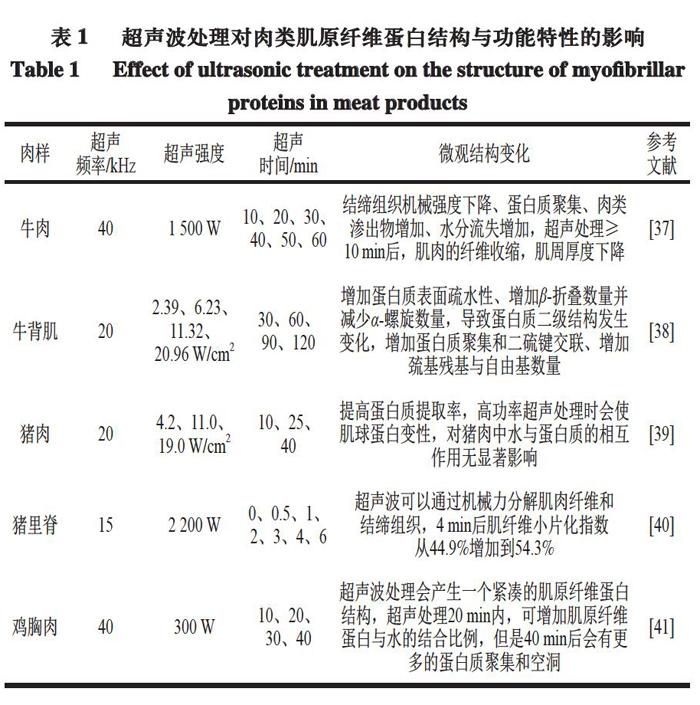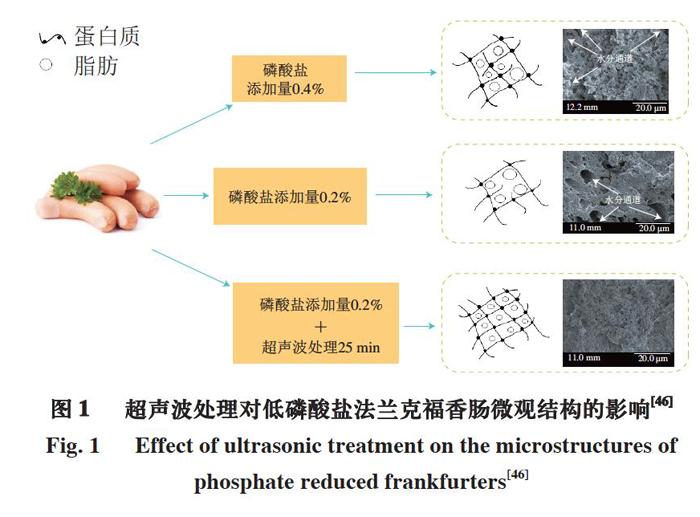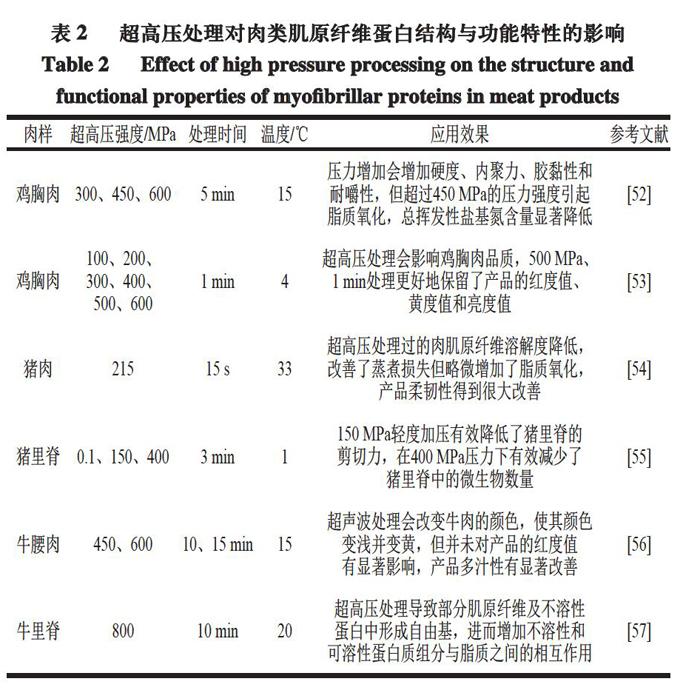基于清洁标签理念的新型加工技术在低磷肉制品中应用的研究进展
2021-05-20赵宏蕾常婧瑶刘美月辛莹杨乐孔保华刘骞
赵宏蕾 常婧瑶 刘美月 辛莹 杨乐 孔保华 刘骞



摘 要:磷酸盐作为一种常见的功能添加剂被广泛用于肉类制品的生产中,其能够有效提升肉的保水性,改善肉制品质构,从而赋予产品良好的嫩度和多汁性。现今,肉制品中磷酸盐含量过高的问题仍旧突出,过量摄入磷酸盐能够对人类健康带来诸多危害。因此,为满足消费者期待的更健康、安全的低磷肉制品的需求,需高度重视基于“清洁标签”理念下的降低肉制品中磷酸盐添加量策略的实施。超声波、超高压、脉冲电场、新型滚揉技术及碱性电解水等新型加工技术能够在修饰肌肉蛋白质结构的同时改善肉制品品质,从而达到在未添加其他清洁标签配料的基础上减少肉制品中磷酸盐含量。本文在前人研究基础上系统综述清洁标签理念的发展、清洁标签肉制品的研发现状以及降低肉制品中磷酸盐含量的新型加工技术,以期为开发“清洁标签”理念的低磷肉制品提供理论和技术参考。
关键词:清洁标签;新型加工技术;低磷肉制品;品质;健康
Recent Development in the Application of Novel Processing Technologies Based on the Clean Label Concept
in Low Phosphate Meat Products
ZHAO Honglei, CHANG Jingyao, LIU Meiyue, XIN Ying, YANG Le, KONG Baohua, LIU Qian*
(College of Food Science, Northeast Agricultural University, Harbin 150030, China)
Abstract: As a common functional food additive, phosphates are widely used in the production of meat products, which can effectively increase the water-holding capacity, improve the textural quality, and consequently improve the tenderness and juiciness of meat products. Now, excessive phosphate content in meat products is still a prominent problem, and excessive intake of phosphate is closely associated with increased disease risks. Thus, in order to meet consumers desire for healthier and safer low phosphate meat products, it is necessary to attach great importance to implementing the strategy to reduce the amount of phosphates added to meat products based on the clean label concept. New processing technologies such as ultrasound, high-pressure processing, pulsed electric field, new tumbling technology and alkaline electrolyzed water can modify the structure of muscle proteins and improve the textural quality of meat products, reducing the amount of phosphates added in meat products without adding other clean label ingredients. Based on previous studies, this paper systematically reviews the development of the clean label concept, the current status of the development of clean label meat products, and the new processing technologies available to reduce the content of phosphates in meat products, with a view to providing theoretical and technical reference for developing clean label meat products with reduced phosphates.
Keywords: clean label; novel processing technologies; low phosphate meat products; quality; health
DOI:10.7506/rlyj1001-8123-20201218-293
中圖分类号:TS251.5
文献标志码:A 文章编号:1001-8123(2021)01-0083-09
引文格式:
赵宏蕾, 常婧瑶, 刘美月, 等. 基于清洁标签理念的新型加工技术在低磷肉制品中应用的研究进展[J]. 肉类研究, 2021, 35(1): 83-91. DOI:10.7506/rlyj1001-8123-20201218-293. http://www.rlyj.net.cn
ZHAO Honglei, CHANG Jingyao, LIU Meiyue, et al. Recent development in the application of novel processing technologies based on the clean label concept in low phosphate meat products[J]. Meat Research, 2021, 35(1): 83-91. DOI:10.7506/rlyj1001-8123-20201218-293. http://www.rlyj.net.cn
磷酸盐在提高肉制品品质、改善肉制品口感以及预防肉制品腐败变质等方面具有十分重要的作用,其在肉制品加工行业得到了广泛使用[1-2]。但近年来,由于肉制品中磷酸盐含量普遍过高导致的食品安全问题逐渐引起了消费者的关注[3]。按照GB 2760—2014《食品安全国家标准 食品添加剂使用标准》[4]规定,肉制品中磷酸盐的最大添加量为5 g/kg,健康成年人每日摄入磷的最大限量为40 mg/kg[5],而人体每日摄入肉制品的量是否超过磷的最大摄入量由人的体质量决定,若一成年人体质量为60 kg,则其每日摄入肉制品的量不宜超过480 g,否则将会达到人体中磷的最大摄入量。若超量摄入会降低机体对钙的吸收,进而导致部分骨骼类疾病[6],并使慢性肾脏病患者的死亡风险增加20%~40%[7-8]。此外,除外部添加的磷酸盐外,生鲜原料肉本身也含有部分磷,故肉制品生产企业按照GB 2760—2014添加磷酸盐时,也可能会超过GB 2726—2016《食品安全国家标准 熟肉制品》[9]中磷酸盐≤5 g/kg的检出限量。因此,消费者基于对自身健康的考虑,逐渐对磷酸盐添加量较多的肉制品,如调理类肉制品、酱卤类肉制品等产品产生不信任感,进而期待低磷的健康肉制品,其与清洁标签追求“天然、健康、安全”的产品理念一致[10]。清洁标签是在产品标签中尽可能少出现E编码(一种区分各种食品添加剂的编码系统),保持标签配料栏中食品的天然属性。在国内外,尽量少用E编码添加剂的清洁标签产品是一种健康的标志,消费者在购买食品时,选择配料表中食品添加剂含量少的产品已经成为一种消费趋势[11]。近年来,研究人员开发出大量以天然物质为基质的清洁标签配料,以达到部分替代磷酸盐的效果[12],但是,过多添加会对最终产品的感官特性造成一定负面影响。如C?mara等[13]将斯勒奇亚籽多糖应用于博洛尼亚香肠中,结果表明,添加2%斯勒奇亚籽多糖能增加产品的弹性和内聚力,并将产品的磷酸盐含量降低至0.25%,但多糖添加量过多会影响产品的口感及整体可接受度。基于此,“绿色、健康、安全”的新型加工技术在既能够降低磷酸盐含量,且不添加其他替代物的同时,保持肉制品良好的口感及特有风味,并具有加工时间短及产品健康、安全等优点,已经逐渐成为清洁标签理念低磷肉制品加工的研究热点[14]。
基于上述消费理念,本文系统综述应用超声波、超高压、脉冲电场、新型滚揉技术及碱性电解水等新型加工技术降低磷酸盐使用量方面的研究进展[15],其在一定程度上替代部分磷酸盐,抑制部分不饱和脂肪酸、蛋白质的氧化,进而延长产品的货架期,生产出的低磷健康肉制品也更为消费者青睐,并极大程度保障了食品的质量安全[16]。本文全面综述清洁标签理念及其在肉制品中的研究现状以及现有的降低磷酸盐含量的新型加工技术,为研发出满足消费者清洁标签理念需求的低磷肉制品提供理论指导。
1 清洁标签
1.1 清洁标签理念
清洁标签理念源于20世纪80年代的英国,为了方便消费者进一步区分各种食品添加剂,欧盟采用了E编码系统,其中包含上百种获准使用的食品添加剂[17],如磷酸盐的E编码为E450~E459。磷酸盐因具有较好的持水、持油能力而在肉品行业得到广泛使用,但磷酸盐摄入量过多会对人体健康产生危害,短时间内可能会造成腹痛、腹泻等不良反应,长期大量摄入还会破坏人体的钙磷平衡,因此,消费者逐渐对自身的健康问题感到焦虑,故逐渐追求“天然、健康、安全”的食品理念[18-19],这与清洁标签追求的产品理念一致[20]。早期的清洁标签在各个国家均未有明确、统一的定义[3],但通过对消费者市场进行调查分析,食品行业逐步总结出一个关于清洁标签的相对成熟的概念:产品中的添加成分绿色、天然、有机;产品中添加剂的含量较少;产品中的成分普遍、精简、易懂;制得的产品更加健康、安全[21]。总体而言,消费者对于清洁标签食品的接受程度很高,认为其是更健康、更安全的选择,这一食品理念不仅逐渐受到消费者的广泛追捧,在低磷肉制品的加工过程中更是备受关注[22]。
1.2 清洁标签肉制品研发现状
近年来,开发清洁标签产品以满足消费者的需求变得十分迫切,研究人员开始转变以往的思路,使产品相对“天然、健康、安全”,以倡导回归自然、追求健康食品的理念[22]。目前研究人员开发了大量以天然物质为基质的清洁标签配料来替代磷酸盐,进而生产更健康、安全的肉制品,如向肉制品中添加多糖、植物蛋白、亲水胶体、菌菇提取物等天然物质,提高了产品的出品率并改善了产品品质,在减少磷酸盐的添加量方面取得了一定进展,但部分天然物质的添加会对产品的感官特性产生一定负面影响,最终影响产品的整体接受度[23-24]。基于此,研究人员将新型加工技术引入降低磷酸盐含量的研究中,且无需添加以天然物质为基质的清洁标签配料,旨在降低磷酸盐的含量并为消费者提供健康、安全的肉制品[25-26]。未来的发展也可将新型加工技术与清洁标签配料协同使用,以进一步生产低磷肉制品。从长远角度來看,具有清洁标签理念的低磷肉制品可能会持续流行,并在未来的研究中可能有着长期的发展和延伸[27]。
2 新型加工技术在低磷肉制品中的应用
随着消费者对清洁标签肉制品的重视程度逐渐增加,新型加工技术在低磷肉制品中的应用取得了一系列重要进展,如超声波、超高压、脉冲电场、新型滚揉技术及碱性电解水等。这些新型加工技术与传统工艺相比,其优势在于降低产品中的磷酸盐含量、减少产品加工时间以及在生产更健康的产品的同时保持食品的感官特性和营养品质[27-28]。此外,新型加工技术还可以增强肌原纤维蛋白的溶解性,修饰蛋白结构,并且有助于其他添加剂的扩散[29-31]。因此,为满足消费者对清洁标签肉制品的需求,本文简要讨论了以下5 种新型加工技术降低肉制品中磷酸盐含量的作用机制及产品效果,为研发出满足消费者清洁标签理念的低磷肉制品提供理论指导。
2.1 超声波
超声波作为一种简单、绿色、节能的新型加工技术,在肉制品加工及应用中具有巨大的潜力[32]。它是一种由电能转换为声能的非热加工技术[33],其产生的能量一部分会转化为热量而损失,其余能量会引起空化效应,进而产生大量气泡,气泡破裂时产生的剪切力可以快速破坏肉的组织结构,进而破坏肌肉微观结构中的Z线和M线[34],从而改变肌动球蛋白的结构,破坏肌动蛋白-肌球蛋白之间相互作用的“桥梁”,使肌动球蛋白解离成肌动蛋白和肌球蛋白[35],蛋白之间产生明显间隙,从而改善产品保水性和凝胶特性[36]。表1总结了超声波处理对肉类肌原纤维蛋白结构与功能特性的影响。超声波作为一项能够改善肌肉微观结构的新型加工技术,在降低磷酸盐添加量的同时不损害肉制品质地和风味,其对清洁标签理念的低磷肉制品研发具有积极意义。
自1950年以来,超声波在肉类行业的解冻、嫩化和抑菌方面应用逐渐增加[42-43]。如今,超声处理也常用来改善肉制品质地、风味和保水性,一些研究讨论了超声处理对肉制品微观结构的影响以及在降低肉制品中磷酸盐添加量方面的积极作用。Li Ke等[44]将鸡肉糜于频率20 kHz、功率450 W的超声浴中超声处理6 min,结果表明,超声处理显著改善了肌原纤维蛋白的乳化性能,有助于形成更均一的肌原纤维网状凝胶结构,并增加活性巯基数量,其在降低肉制品磷酸盐添加量方面显示出巨大的潜力。Pinton等[45]将磷酸盐含量为0.25%的肉糜于频率25 kHz、功率230 W的超声浴处理0、18、27 min,对产品的乳化稳定性、pH值、质构特性及感官评价等进行研究,结果表明,经超声处理的产品与对照组相比,硫代巴比妥酸反应物值未增加,且其感官评价相对较好,并对产品中降低氯化钠的含量也有积极影响。此外,在本课题组前期的研究中发现,25 min超声(频率25 kHz、功率240 W)处理可以显著减少低磷酸盐法兰克福香肠的蒸煮损失,提高其乳化稳定性、质构特性和感官评分,并通过产品动态水分布分析和微观结构观察验证了上述结果;与此同时,如图1所示,与对照组相比,未经过超声处理的低磷酸盐添加量处理组的三维网状结构不紧密、不均匀,且在整个网状结构中还存在一些较大的孔洞,而超声波处理25 min时可发生空化效应,导致产品的蛋白网状结构间的孔径明显减小,同时形成更紧凑、均匀、致密的微观结构,以保持更多的水分[46]。虽然超声波技术是一种新型绿色加工技术,但在实际应用中超声波会产生高能量及高活性自由基,其是否会产生有害物质尚未见报道[47]。此外,超声波仪器的成本问题也导致其在实际生产中尚未得到充分应用。因此,如何将现有的研究成果综合运用到肉品行业仍是一个值得思考的问题。
2.2 超高压
超高压处理是一种新型非热加工技术,可对食品进行巴氏消毒,同时也可以保留食品某些特有的风味及口感[48],也有大量研究表明该技术可有效延长肉类产品的货架期[49]。此外,超高压处理会引起肉类蛋白之间的非共价相互作用,进而诱导蛋白质变性、聚集及胶凝现象,最终改善肉制品的持水能力、保持其柔嫩多汁的口感[50],并对生产更健康、更安全的肉类产品有着积极作用。随着消费者对清洁标签肉制品的需求不断增长,肉类工业逐步减少产品中磷酸盐的含量,以减少消费者对健康问题的担忧。基于此,研究人员将超高压处理应用于低磷肉制品中以提高产品的质构特性及整体可接受度,同时保证了肉制品的健康性及安全性[51]。表2总结了超高压处理对肉类肌原纤维蛋白结构与功能特性的影响,为低磷肉制品的研发提供了理论指导。
Villamonte等[58]将猪肉糜进行350 MPa、6 min的超高压处理,对磷酸盐添加量为0.25%~0.50%的猪肉糜质地、颜色、蒸煮损失及质构特性等进行评估,结果表明,磷酸盐添加量0.25%的肉糜蒸煮损失最低,与1.5%食盐或3%食盐的协同效果最佳,处理组产品的亮度值和黄度值均较对照组高,且不会改變熟肉糜的内聚性和硬度,产品的整体可接受度较高。Zheng Haibo等[59]将鸡肉肠进行200 MPa、30 min的超高压处理协同75 ℃热处理,对产品的外观、持水能力、质构特性等指标进行分析,结果表明,该产品具有较高的持水能力和良好的质地,可用于生产低磷酸盐乳化肉糜类制品,但需要进一步的研究来了解超高压与高温相结合对肌原纤维的影响,且需补充肌肉蛋白质解聚和聚集的详细机理,以探究其对低磷肉制品品质的影响。此外,OFlynn等[60]对猪肉肠进行150~300 MPa、5 min的超高压处理,对产品的成分、乳化稳定性、颜色、质构特性及感官评价进行分析,结果表明,与对照组猪肉肠相比,磷酸盐添加量0.25%时产品硬度、内聚性和咀嚼性均得到显著改善,但产品的红度值较高,可接受度也受到轻微影响。超高压处理是一种开发新型健康肉制品的有效策略[61],其可降低肉制品的蒸煮损失,进而降低磷酸盐含量,但过高的压力会造成蛋白质构象的改变及ATP酶活性的丧失,进而使蛋白质在加热过程中形成的分子间交联能力变弱,最终导致肉制品持水能力显著下降[62],产品的色泽、风味也可能会受到轻微影响。因此,在控制适度的压力范围内,超高压处理能达到较好的产品效果。总之,经超高压处理的肉制品具有相对安全健康、营养成分损失较少等特点,在清洁标签理念的低磷肉制品研发中具有很好的应用前景。
2.3 脉冲电场
脉冲电场是一种应用于食品行业中的非热加工技术,其实用性得到肉品行业极大程度地认同,它是一种适用于液体和半固体间的创新型食品加工技术[63],其原理是在2 个电极之间施加电流,从而引起电穿孔现象,进而实现对食品组织结构的修饰,对肉制品的贮藏、嫩化和保水等方面有积极影响。高电场强度的脉冲作用能够影响脂肪酸与细胞膜磷脂之间的相互作用,扩大肌肉细胞膜现有的孔洞或产生新孔洞,进而增加细胞膜的渗透性[64-65],可以显著改善肉制品对磷酸盐、亚硝酸盐等添加剂的吸收,提高其在肉制品中的吸收率,进而减少添加剂的添加量和产品所需的加工时间。此外,脉冲电场诱导的静电相互作用会破坏蛋白质的修饰结构,表3总结了脉冲电场对肉类肌原纤维蛋白结构与功能特性的影响,进而改善肉的结构和质地,使肉制品肉嫩多汁且富有弹性[66],有助于清洁标签理念的低磷肉制品的开发。
Dong Ming等[72]将鸡胸肉中提取的肌原纤维蛋白置于不同电场强度(0~28 kV/cm)和脉冲频率(0~1 000 Hz)的电场中,研究其对肌原纤维蛋白理化性质和构象的影响,结果表明,随着脉冲电场强度的增加,α-螺旋含量增加且β-转角和无规卷曲含量减少,肌原纤维蛋白的溶解度、表面疏水性和巯基含量均得到明显改善,可作为一种应用于肉制品的有前景的绿色降磷技术。但是,当电场强度超过18 kV/cm时,官能团的相互作用会引起蛋白质的聚集,降低肌原纤维蛋白的保水性,且产品可接受度会受到轻微影响。尽管脉冲电场是一项创新型非热加工技术,但在高强度电场处理时产生的热量会导致肌原纤维蛋白温度升高,甚至导致肌原纤维蛋白变性[73],进而降低肉制品持水能力,故低强度脉冲电场必须保证肌原纤维蛋白处于不变性的状态,再进一步降低肉制品中磷酸盐含量。此外,根据加工参数和处理条件,必须考虑脉冲电场的副作用(如肌原纤维蛋白温度升高或发生电化学反应等),以保持食品质量。总之,尽管脉冲电场降低肉制品中磷酸盐含量的相关研究较少,但也是未来开发清洁标签理念低磷肉制品的一个很好的研究方向。
2.4 新型滚揉技术
滚揉技术能够改善肉制品的嫩度、色泽,并能促进盐溶性蛋白的溶出[73],但传统滚揉技术受真空度、温度等条件的影响,若处理条件控制不当,会造成耗时过长、颜色劣变及过度失水等风险[74]。近年来,有研究表明,将滚揉工艺与其他工艺结合的新型滚揉技术,如超声辅助变压滚揉、超声辅助呼吸滚揉等能够有效促进食盐、磷酸盐等添加剂的渗透和扩散,进而减少添加剂的使用量,同时显著提高产品的嫩度和口感[75-76]。在产品的滚揉过程中,通过调整滚筒内的压力,使原料肉交替处于压缩和舒张状态,进而使原料肉呈现呼吸模式,从而有利于盐溶性蛋白的溶出和添加剂的渗透,以提高滚揉腌制效果[77],且超声波技术的空化作用、超高压技术的机械作用能辅助滚揉腌制的呼吸模式,破坏肉中的肌原纤维蛋白,使得细胞的内容物释放,蛋白质间空隙变大,从而起到提升肉制品持水能力的作用[78]。透射电镜观察结果也表明新型滚揉技术对肉类微观结构有显著影响[79]。新型滚揉技术可以在降低磷酸盐添加量的同时提高产品的嫩度和风味,对清洁标签理念低磷肉制品的研发具有积极意义。
Li Yan等[80]将鸡胸肉放置于超声辅助呼吸滚揉设备中,结果表明,超声辅助呼吸滚揉技术提高了鸡胸肉的腌制吸收率,产品的嫩度和风味也得到一定程度的改善,且α-螺旋数量显著降低,β-折叠数量显著提高,不易流动水含量增加,产品的持水能力提高,因此,超声辅助呼吸滚揉技术可作为一种潜在的降低肉制品中磷酸盐含量的新型加工技术。李鹏等[79]将磷酸盐添加量0.3%的鸡胸肉放置于超声辅助变压滚揉设备中处理100 min,结果表明,经超声辅助变压滚揉处理的产品水分子与蛋白质之间结合更紧密,部分自由水变成不易流动水,产品的持水能力明显提高。但是,新型滚揉技术通常对于滚揉设备的要求较高,需要使用专业的耐高压材料及质量较好的填充气体[81],且在加工过程中需要注意加工时间,以避免加工过程中肌原纤维蛋白发生变性,这也进一步增加了生产成本,因此目前也处于研究阶段,需要研发人员进一步探索其在降低磷酸盐添加量方面的应用。总之,经新型滚揉技术处理的肉制品品质得到很大程度的改善,其在清洁标签理念低磷肉制品的研发中具有很好的应用前景。
2.5 碱性电解水
碱性电解水通常是由电解盐溶液而得,其中氢离子和钠离子等带正电的离子向阴极移动,进而生成氢气和氢氧化钠[82],使碱性电解水携带较多负电荷,并具有较强的还原能力[83-84],可明显提高肉制品的pH值,导致肌原纤维蛋白pH值远离其等电点,蛋白质之间的静电排斥力增加,结构变松弛,水进入蛋白质之间的空隙,从而具有较强的滲透力和溶解性以及很强的抗氧化性[85]。通常在食品中关于碱性电解水的研究主要集中在其与酸性和弱酸性电解水进行组合,以增强产品的抗菌效果[86],关于其降低肉制品中氯化钠含量的研究也已得到证实[87],但其降低肉制品中磷酸盐含量方面的研究相对较少。表4总结了碱性电解水对肉类肌原纤维蛋白结构与功能特性的影响,其在未来降低磷酸盐使用量方面可能会具有很大的发展潜力。
Lin Huimin等[88]用pH值为11.6的碱性电解水部分替代磷酸盐,研究其对鲶鱼片持水能力、色泽、质地和脂质氧化的影响,结果表明,碱性电解水提高了鲶鱼片的持水能力,可将磷酸盐添加量降低50%,产品的抗氧化性比使用磷酸盐的处理组效果更好,但碱性电解水对产品的亮度值、硬度及弹性没有显著影响。碱性电解水具有较强的持水能力及抗氧化特性,可以在降低磷酸盐添加量的同时保持肉制品肉嫩多汁的口感,有助于清洁标签理念低磷肉制品的开发。但是,当肉制品pH值过高时会严重影响产品口感,需要进一步注意碱性电解水的用量,且碱性电解水在实际生产中应用也需关注以下问题,包括不同贮藏条件下碱性电解水的稳定性、耐腐蚀性和氯酸盐残留量等问题,其对更多肉制品的影响还需要进一步研究。此外,碱性电解水可进一步与其他新型技术结合使用,进而降低磷酸盐在产品中的添加量,改善产品品质,是未来开发清洁标签理念低磷肉制品的一个很好的研究方向。
3 结 语
磷酸盐作为应用于乳化肉糜制品中重要的保水剂和改良剂,在提高产品的质地和风味等方面有着重要的作用,但随着人们生活质量不断提高,消费者对于磷酸盐摄入量过多会带来健康危害这一认知也逐渐清晰,进而越来越注重食品的天然、健康及安全问题,进一步期待清洁标签理念的低磷肉制品。因此,在食品加工过程中,研究人员开发了众多新型加工技术降低磷酸盐在肉制品中的含量,同时也保留了肉制品原有的风味、口感和营养成分。除提供更健康的产品特性外,新型加工技术还具备提高肉制品产量、延长货架期等优势。在低磷肉制品的研究方面,超声波、超高压、脉冲电场、新型滚揉及碱性电解水技术均取得了初步进展,但还需更多研究其在低磷肉制品中研发的巨大潜力,如新型加工技术是否会对低磷肉制品在人体内的消化吸收产生影响等。此外,基于目前的研究思路,新型加工技术之间结合使用、清洁标签配料与新型加工技术结合使用在降低磷酸盐使用量方面也具有巨大的研究潜力,需要进一步研究其对低磷肉制品产生的积极效果。
参考文献:
[1] POWELL M J, SEBRANEK J G, PRUSA K J, et al. Evaluation of citrus fiber as a natural replacer of sodium phosphate in alternatively-cured all-pork Bologna sausage[J]. Meat Science, 2019, 157: 1-7. DOI:10.22175/rmc2017.042.
[2] 张芸, 卞春丽, 张亚娟, 等. 磷酸盐对乳化肠持水性的影响[J]. 现代食品, 2017(19): 104-106. DOI:10.16736/j.cnki.cn41-1434/ts.2017.19.030.
[3] Bánáti d. Consumer response to food scandals and scares[J]. Trends in Food Science and Technology, 2011, 22(2/3): 56-60. DOI:10.1016/j.tifs.2010.12.007.
[4] 中华人民共和国卫生部. 食品安全国家标准 食品添加剂使用标准: GB 2760—2014[S]. 北京: 中国标准出版社, 2014.
[5] YOUNES M, AQUILINA G, CASTLE L, et al. Re-evaluation of phosphoric acid-phosphates-di-, tri- and polyphosphates (E338-341, E343, E450-452) as food additives and the safety of proposed extension of use[J]. EFSA Journal, 2019, 17(6): 5674. DOI:10.2903/j.efsa.2019.5674.
[6] 王鐵良, 李瑾, 王会锋, 等. 食品添加剂-复合磷酸盐的分析研究[J]. 食品工业科技, 2007(12): 201-203. DOI:10.13386/j.issn1002-0306.2007.12.048.
[7] SINHA A, PRASAD N. Dietary management of hyperphosphatemia in chronic kidney disease[J]. Clinical Queries Nephrology, 2014, 3(1): 38-45. DOI:10.1016/j.cqn.2014.03.003.
[8] TENTORI F, BLAYNEY M J, ALBERT J M, et al. Mortality risk for dialysis patients with different levels of serum calcium, phosphorus, and PTH: the dialysis outcomes and practice patterns study (DOPPS)[J]. American Journal of Kidney Diseases, 2008, 52(3): 519-530. DOI:10.1053/j.ajkd.2008.03.020.
[9] 中华人民共和国国家卫生和计划生育委员会, 国家食品药品监督管理总局. 食品安全国家标准 熟肉制品: GB 2726—2016[S]. 北京: 中国标准出版社, 2016.
[10] Asioli d, Aschemann-Witzel J, Caputo v. Making sense of the “clean label” trends: a review of consumer food choice behavior and discussion of industry implications[J]. Food Research International, 2017, 99: 58-71. DOI:10.1016/j.foodres.2017.07.022.
[11] Busken, David F. Cleaning it up: what is a clean label ingredient?[J]. Cereals Foods Worlds, 2013, 60(2): 112-113. DOI:10.1094/CFW-60-2-0112.
[12] Thangavelu K P, Kerry J P, Tiwari B K, et al. Novel processing technologies and ingredient strategies for the reduction of phosphate additives in processed meat[J]. Trends in Food Science and Technology, 2019, 94: 43-53. DOI:10.1016/j.tifs.2019.10.001.
[13] C?mara a k f l, Vidal v a s, Santos m, et al. Reducing phosphate in emulsified meat products by adding chia (Salvia hispanica L.) mucilage in powder or gel format: a clean label technological strategy[J]. Meat Science, 2020, 163: 108085. DOI:10.1016/j.meatsci.2020.108085.
[14] Chemat F, Rombaut N, Meullemiestre A, et al. Review of green food processing techniques. Preservation, transformation, and extraction[J]. Innovative Food Science and Emerging Technologies, 2017, 41: 357-377. DOI:10.1016/j.ifset.2017.04.016.
[15] Pe?a M M l, Welti-Chanes J, Martin-Belloso o, et al. Novel technologies to improve food safety and quality[J]. Current Opinion in Food Science, 2019, 30: 1-7. DOI:10.1016/j.cofs.2018.10.009.
[16] Troy D J, Ojha K S, Kerry J P, et al. Sustainable and consumer-friendly emerging technologies for application within the meat industry: an overview[J]. Meat Science, 2016, 120: 2-9. DOI:10.1016/j.meatsci.2016.04.002.
[17] Maruyama s, Streletskaya n a, Lim j. Clean label: why this ingredient but not that one?[J]. Food Quality and Preference, 2020, 87: 104062. DOI:10.1016/j.foodqual.2020.104062.
[18] Rose n, Reynolds t, Kolodinsky j, et al. P90 consumer use of food labels increases as “Clean Label” trend continues[J]. Journal of Nutrition Education and Behavior, 2020, 52(7): 58-59. DOI:10.1016/j.jneb.2020.04.136.
[19] Meneses Y, Cannon K J, Flores R A, et al. Keys to understanding and addressing consumer perceptions and concerns about processed foods[J]. Cereal Foods World, 2014, 59(3): 141-146. DOI:10.1094/CFW-59-3-0141.
[20] Román S, Sánchez-Siles L M, Siegrist M, et al. The importance of food naturalness for consumers: results of a systematic review[J]. Trends in Food Science and Technology, 2017, 67: 44-57. DOI:10.1016/j.tifs.2017.06.010.
[21] Varela p, Fiszman s m. Exploring consumers knowledge and perceptions of hydrocolloids used as food additives and ingredients[J]. Food Hydrocolloids, 2013, 30(1): 477-484. DOI:10.1016/j.foodhyd.2012.07.001.
[22] 張连慧, 应欣, 王勇. 清洁标签在食品行业中的应用[J]. 食品科技, 2018, 43(6): 326-330. DOI:10.13684/j.cnki.spkj.2018.06.060.
[23] Chattopadhyay K, Xavier K M, Layana P, et al. Chitosan hydrogel inclusion in fish mince based emulsion sausages: effect of gel interaction on functional and physicochemical qualities[J]. International Journal of Biological Macromolecules, 2019, 134: 1063-1069. DOI:10.1016/j.ijbiomac.2019.05.148.
[24] Choe J, Lee J, Jo K, et al. Application of winter mushroom powder as an alternative to phosphates in emulsion-type sausages[J]. Meat Science, 2018, 143: 114-118. DOI:10.1016/j.meatsci.2018.04.038.
[25] Rastogi N K. Opportunities and challenges in application of ultrasound in food processing[J]. Critical Reviews in Food Science and Nutrition, 2011, 51(8): 705-722. DOI:10.1080/10408391003770583.
[26] Pinton m s, Santos b a, Lorenzo j m, et al. Green technologies as a strategy to reduce NaCl and phosphate in meat products: an overview[J]. Current Opinion in Food Science, 2021, 40: 1-5. DOI:10.1016/j.cofs.2020.03.011.
[27] Silva J S D, Voss M, Menezes C R d, et al. Is it possible to reduce the cooking time of mortadellas using ultrasound without affecting their oxidative and microbiological quality?[J]. Meat Science, 2020, 159: 107949. DOI:107947.10.1016/j.meatsci.2019.107947.
[28] Cichoski A J, Rampelotto C, Silva M S, et al. Ultrasound-assisted post-packaging pasteurization of sausages[J]. Innovative Food Science and Emerging Technologies, 2015, 30: 132-137. DOI:10.1016/j.ifset.2015.04.011.
[29] CHEN Xing, LIANG Li, XU Xinglian. Advances in converting of meat protein into functional ingredient via engineering modification of high pressure homogenization[J]. Trends in Food Science and Technology, 2020, 106: 12-29. DOI:10.1016/j.tifs.2020.09.032.
[30] Bhat Z F, Morton J D, Mason S L, et al. Current and future prospects for the use of pulsed electric field in the meat industry[J]. Critical Reviews in Food Science and Nutrition, 2019, 59: 1660-1674. DOI:10.1080/10408398.2018.1425825.
[31] Bhat Z F, Morton J D, Mason S L, et al. The application of pulsed electric field as a sodium reducing strategy for meat products[J]. Food Chemistry, 2020, 306: 125622. DOI:10.1016/j.foodchem.2019.125622.
[32] Alarcon-Rojo A D, Carrillo-Lopez L M, Reyes-Villagrana R, et al. Ultrasound and meat quality: a review[J]. Ultrasonics Sonochemistry, 2019, 55: 369-382. DOI:10.1016/j.ultsonch.2018.09.016.
[33] Berlan J, Mason T J. Sonochemistry: from research laboratories to industrial plants[J]. Ultrasonics, 1992, 30: 203-212. DOI:10.1016/0041-624X(92)90078-Z.
[34] Zou Yunhe, Zhang Wangang, Kang Dacheng, et al. Improvement of tenderness and water holding capacity of spiced beef by the application of ultrasound during cooking[J]. International Journal of Food Science and Technology, 2018, 53: 828-836. DOI:10.1111/ijfs.13659.
[35] BRASIL C C B, BARIN J S, JACOB-LOPES E, et al. Single step non-thermal cleaning/sanitation of knives used in meat industry with ultrasound[J]. Food Research International, 2017, 91: 133-139. DOI:10.1016/j.foodres.2016.11.030.
[36] Amiri A, Sharifian P, Soltanizadeh N, et al. Application of ultrasound treatment for improving the physicochemical, functional and rheological properties of myofibrillar proteins[J]. International Journal of Biological Macromolecules, 2018, 111: 139-147. DOI:10.1016/j.ijbiomac.2017.12.167.
[37] CHANG Haijun, WANG Qiang, TANG Chunhong, et al. Effects of ultrasound treatment on connective tissue collagen and meat quality of beef semitendinosus muscle[J]. Journal of Food Quality, 2015, 38: 256-267. DOI:10.1111/jfq.12141.
[38] KANG Dacheng, ZOU Yunhe, CHEN Yuping, et al. Effects of power ultrasound on oxidation and structure of beef proteins during curing processing[J]. Ultrasonics Sonochemistry, 2016, 33: 47-53. DOI:10.1016/j.ultsonch.2016.04.024.
[39] Yeung C K, Huang S C. Effects of ultrasound pretreatment and ageing processing on quality and tenderness of pork loin[J]. Journal of Food and Nutrition Research, 2017, 5: 809-816. DOI:10.12691/jfnr-5-11-3.
[40] McDonnell C K, Allen P, Morin C, et al. The effect of ultrasonic salting on protein and water-protein interactions in meat[J]. Food Chemistry, 2014, 147: 245-251. DOI:10.1016/j.foodchem.2013.09.125.
[41] Saleem R, Ahmad R. Effect of ultrasonication on secondary structure and heat induced gelation of chicken myofibrils[J]. Journal of Food Science and Technology, 2016, 53: 3340-3348. DOI:10.1007/s13197-016-2311-z.
[42] Caraveo O, Alarcon-Rojo A D, Renteria A, et al. Physicochemical and microbiological characteristics of beef treated with high-intensity ultrasound and stored at 4 ℃[J]. Journal of the Science of Food and Agriculture, 2015, 95: 2487-2493. DOI:10.1002/jsfa.6979.
[43] Pe?a-González E M, Alarcón-Rojo A D, Rentería A, et al. Quality and sensory profile of ultrasound-treated beef[J]. Italian Journal of Food Science, 2017, 29: 463-475. DOI:10.14674/1120-1770/ijfs.v604.
[44] LI Ke, KANG Zhuangli, ZHAO Yingying, et al. Use of high-intensity ultrasound to improve functional properties of batter suspensions prepared from PSE-like chicken breast meat[J]. Food Bioprcess Technology, 2014, 7(12): 3466-3477. DOI:10.1007/s11947-014-1358-y.
[45] PINTON M B, CORREA L P, FACCHI M M X, et al. Ultrasound: a new approach to reduce phosphate content of meat emulsions[J]. Meat Science, 2019, 152: 88-95. DOI:10.1016/j.meatsci.2019.02.010.
[46] ZHANG Fengxue, ZHAO Honglei, CAO Chuanai, et al. Application of temperature-controlled ultrasound treatment and its potential to reduce phosphate content in frankfurter-type sausages by 50%[J]. Ultrasonics Sonochemistry, 2021, 71: 105379. DOI:10.1016/j.ultsonch.2020.105379.
[47] 黃亚军, 周存六. 超声波技术在肉及肉制品中的应用研究进展[J]. 肉类研究, 2020, 34(5): 91-97. DOI:10.7506/rlyj1001-8123-20200319-079.
[48] Rastogi N K, Raghavarao K S M S, Balasubramaniam V M,
et al. Opportunities and challenges in high pressure processing of foods[J]. Critical Reviews in Food Science and Nutrition, 2007, 47: 69-112. DOI:10.1080/10408390600626420.
[49] Diez A M, Urso R, Rantsiou K, et al. Spoilage of blood sausages morcilla de Burgos treated with high hydrostatic pressure[J]. Meat Science, 2008, 123: 246-253. DOI:10.1016/j.ijfoodmicro.2008.02.017.
[50] Vanga s k, Singh A, Raghavan V. Changes in soybean trypsin inhibitor by varying pressure and temperature of processing: a molecular modeling study[J]. Innovative Food Science and Emerging Technologies, 2018, 49: 31-40. DOI:10.1016/j.ifset.2018.07.015.
[51] Mújica H, Valdez A, Tonello C, et al. High pressure processing technologies for the pasteurization and sterilization of foods[J]. Food and Bioprocess Technology, 2011, 4: 969-985. DOI:10.1007/s11947-011-0543-5.
[52] Kruk Z A, Yun H, Rutley D L, et al. The effect of high pressure on microbial population, meat quality and sensory characteristics of chicken breast fillet[J]. Food Control, 2011, 22(1): 6-12. DOI:10.1016/j.foodcont.2010.06.003.
[53] Cap m, Paredes p f, Fernández d, et al. Effect of high hydrostatic pressure on Salmonella spp inactivation and meat-quality of frozen chicken breast[J]. LWT-Food Science and Technology, 2020, 118: 108873. DOI:10.1016/j.lwt.2019.108873.
[54] Souza C M, Boler D D, Clark D L, et al. The effects of high pressure processing on pork quality, palatability, and further processed products[J]. Meat Science, 2011, 87(4): 419-427. DOI:10.1016/j.meatsci.2010.11.023.
[55] Hwang s i, Hong g p. Effects of high pressure in combination with the type of aging on the eating quality and biochemical changes in pork loin[J]. Meat Science, 2020, 162: 108028. DOI:10.1016/j.meatsci.2019.108028.
[56] Sun s q, Rasmussen f d, Cavender g a, et al. Texture, color and sensory evaluation of sous-vide cooked beef steaks processed using high pressure processing as method of microbial control[J]. LWT-Food Science and Technology, 2019, 103: 169-177. DOI:10.1016/j.lwt.2018.12.072.
[57] Bolumar T, Andersen M L, Orlien V, et al. Mechanisms of radical formation in beef and chicken meat during high pressure processing evaluated by electron spin resonance detection and the addition of antioxidants[J]. Food Chemistry, 2014, 150: 422-428. DOI:10.1016/j.foodchem.2013.10.161.
[58] Villamonte G, Simonin H, Duranton F, et al. Functionality of pork meat proteins: impact of sodium chloride and phosphates under high-pressure processing[J]. Innovative Food Science and Emerging Technologies, 2013, 18: 15-23. DOI:10.1016/j.ifset.2012.12.001.
[59] ZHENG Haibo, XIONG Guoyuan, HAN Minyi, et al. High pressure/thermal combinations on texture and water holding capacity of chicken batters[J]. Innovative Food Science and Emerging Technologies, 2015, 30: 8-14. DOI:10.1016/j.ifset.2015.06.002.
[60] OFLYNN C C, CRUZ-ROMERO M C, TROY D J, et al. The application of high-pressure treatment in the reduction of phosphate levels in breakfast sausages[J]. Meat Science, 2014, 96(1): 633-639. DOI:10.1016/j.meatsci.2013.08.028.
[61] Xue siwen, Wang huhu, Yang huijuan, et al. Effects of high-pressure treatments on water characteristics and juiciness of rabbit meat sausages: role of microstructure and chemical interactions[J]. Innovative Food Science and Emerging Technologies, 2017, 41: 150-159. DOI:10.1016/j.ifset.2017.03.006.
[62] 錢畅, 薛思雯, 徐幸莲, 等. 超高压及三聚磷酸钠质量分数对肌球蛋白凝胶保水性及热胶凝过程的影响[J]. 食品科学, 2019, 40(1): 92-101.
DOI:10.7506/spkx1002-6630-20171222-281.
[63] Ricci A, Parpinello G P, Versari A, et al. Recent advances and applications of pulsed electric fields (PEF) to improve polyphenol extraction and color release during red winemaking[J]. Beverages, 2018, 4(1): 18. DOI:10.3390/beverages4010018.
[64] Chauhan O P, Unni L E. Pulsed electric field (PEF) processing of foods and its combination with electron beam processing[M]//Electron Beam Pasteurization and Complementary Food Processing Technologies. Woodhead Publishing, 2015: 157-184. DOI:10.1533/9781782421085.2.157.
[65] Faridnia F, Ma Q L, Bremer P J, et al. Effect of freezing as pre-treatment prior to pulsed electric field processing on quality traits of beef muscles[J]. Innovative Food Science and Emerging Technologies, 2015, 29: 31-40. DOI:10.1016/j.ifset.2014.09.007.
[66] WEI Jingni, ZENG Xinan, TANG Ting, et al. Unfolding and nanotube formation of ovalbumin induced by pulsed electric field[J]. Innovative Food Science and Emerging Technologies, 2018, 45: 249-254. DOI:10.1016/j.ifset.2017.10.011.
[67] Via s, Alan c, Remy v d v, et al. Effect of pulsed electric field treatment on hot-boned muscles of different potential tenderness[J]. Meat Science, 2015, 105: 25-31. DOI:10.1016/j.meatsci.2015.02.009.
[68] Alahakoon A U, Oey I, Silcock P, et al. Understanding the effect of pulsed electric fields on thermostability of connective tissue isolated from beef pectoralis muscle using a model system[J]. Food Research International, 2017, 100: 261-267. DOI:10.1016/j.foodres.2017.08.025.
[69] Arroyo c, Eslami S, Brunton N P, et al. An assessment of the impact of pulsed electric fields processing factors on oxidation, color, texture, and sensory attributes of Turkey breast meat[J]. Poultry Science, 2015, 94(5): 1088-1095. DOI:10.3382/ps/pev097.
[70] Ma q l, Hamid n, Oey i, et al. Effect of chilled and freezing pre-treatments prior to pulsed electric field processing on volatile profile and sensory attributes of cooked lamb meats[J]. Innovative Food Science and Emerging Technologies, 2016, 37: 359-374. DOI:10.1016/j.ifset.2016.04.009.
[71] STEEN L, NEYRINCK E, MEY E D, et al. Impact of raw ham quality and tumbling time on the technological properties of polyphosphate-free cooked ham[J]. Meat Science, 2020, 164: 108093. DOI:10.1016/j.meatsci.2020.108093.
[72] DONG Ming, XU Yujuan, ZHANG Yumei, et al. Physicochemical and structural properties of myofibrillar proteins isolated from pale, soft, exudative (PSE)-like chicken breast meat: effects of pulsed electric field (PEF)[J]. Innovative Food Science and Emerging Technologies, 2020, 59: 102277. DOI:10.1016/j.ifset.2019.102277.
[73] Barba F J, Parniakov O, Pereira S A, et al. Current applications and new opportunities for the use of pulsed electric fields in food science and industry[J]. Food Research International, 2015, 77: 773-798. DOI:10.1016/j.foodres.2015.09.015.
[74] YUSOP S M, OSULLIVAN M G, KERRY J F, et al. Influence of processing method and holding time on the physical and sensory qualities of cooked marinated chicken breast fillets[J]. Food Science and Technology, 2012, 46(1): 363-370. DOI:10.1016/j.lwt.2011.08.007.
[75] Siró I, VéN C, Balla C, et al. Application of an ultrasonic assisted curing technique for improving the diffusion of sodium chloride in porcine meat[J]. Journal of Food Engineering, 2009, 91(2): 353-362. DOI:10.1016/j.jfoodeng.2008.09.015.
[76] MIRADE P S, PORTANGUEN S, SICARD J, et al. Impact of tumbling operating parameters on salt, water and acetic acid transfers during biltong-type meat processing[J]. Journal of Food Engineering, 2020, 265: 109686. DOI:10.1016/j.jfoodeng.2019.109686.
[77] 馮婷, 孙京新, 徐幸莲, 等. 超声波辅助变压滚揉对鸡肉腌制品质的影响[J]. 现代食品科技, 2015, 31(5): 248-254. DOI:10.13982/j.mfst.1673-9078.2015.5.039.
[78] INGUGLIA E S, BURGESS C M, KERRY J P, et al. Ultrasound-assisted marination: role of frequencies and treatment time on the quality of sodium-reduced poultry meat[J]. Foods, 2019, 8(10): 473. DOI:10.3390/foods8100473.
[79] 李鹏, 王红提, 孙京新, 等. 超声辅助变压滚揉对鸡肉蛋白质结构及含水量的影响[J]. 农业工程学报, 2017, 33(16): 308-314. DOI:10.11975/j.issn.1002-6819.2017.16.040.
[80] LI Yan, FENG Ting, SUN Jingxin, et al. Physicochemical and microstructural attributes of marinated chicken breast influenced by breathing ultrasonic tumbling[J]. Ultrasonics Sonochemistry, 2020, 64: 105022. DOI:10.1016/j.ultsonch.2020.105022.
[81] 李鵬, 孙京新, 冯婷, 等. 不同滚揉腌制对鸭肉蛋白及水分分布的
影响[J]. 中国食品学报, 2019, 19(10): 163-170. DOI:10.16429/j.1009-7848.2019.10.019.
[82] HUANG Yuru, HUNG Y C, HSU S Y, et al. Application of electrolyzed water in the food industry[J]. Food Control, 2008, 19: 329-345. DOI:10.1016/j.foodcont.2007.08.012.
[83] WANG Huhu, DUAN Debao, WU Zhongyuan, et al. Primary concerns regarding the application of electrolyzed water in the meat industry[J]. Food Control, 2019, 95: 50-56. DOI:10.1016/j.foodcont.2018.07.049.
[84] LI Zhihao, ZHOU Bin, LI Xiuting, et al. Effect of alkaline electrolyzed water on physicochemical and structural properties of apricot protein isolate[J]. Food Science and Biotechnology, 2018, 28(1): 15-23. DOI:10.1007/s10068-018-0439-5.
[85] ATHAYDE D R, MARTINS F D R, DA S J S, et al. Application of electrolyzed water for improving pork meat quality[J]. Food Research International, 2017, 100(1): 757-763. DOI:10.1016/j.foodres.2017.08.009.
[86] Jadeja r, Hung y. Efficacy of near neutral and alkaline pH electrolyzed oxidizing waters to control Escherichia coli O157:H7 and Salmonella typhimurium DT 104 from beef hides[J]. Food Control, 2014, 41: 17-20. DOI:10.1016/j.foodcont.2013.12.030.
[87] LEES Y S V, PINTON M B, ROSA C T D A, et al. Ultrasound and basic electrolyzed water: a green approach to reduce the technological defects caused by NaCl reduction in meat emulsions[J]. Ultrasonics Sonochemistry, 2019, 61: 104830. DOI:10.1016/j.ultsonch.2019.104830.
[88] LIN Huimin, HUNG Y C, DENG Shanggui. Effect of partial replacement of polyphosphate with alkaline electrolyzed water (AEW) on the quality of catfish fillets[J]. Food Control, 2020, 112: 107117. DOI:10.1016/j.foodcont.2020.107117.
[89] LI Yufeng, ZENG Qiaohui, LIU Guang, et al. Effects of ultrasound-assisted basic electrolyzed water (BEW) extraction on structural and functional properties of Antarctic krill (Euphausia superba) proteins[J]. Ultrasonics Sonochemistry, 2020, 71: 105364. DOI:10.1016/j.ultsonch.2020.105364.
收稿日期:2020-12-18
基金项目:黑龙江省“百千万”工程科技重大专项课题(2020ZX07B02)
第一作者简介:赵宏蕾(1997—)(ORCID: 0000-0001-8566-2342),女,硕士研究生,研究方向为畜产品加工工程。
E-mail: zhaohonglei0829@163.com
通信作者简介:刘骞(1981—)(ORCID: 0000-0003-1692-3267),男,教授,博士,研究方向为畜产品加工工程。
E-mail: liuqian@neau.edu.cn
